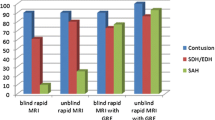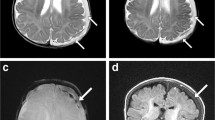Abstract
Subdural hematomas (SDHs) comprise a significant percentage of missed intracranial hemorrhage on axial brain CT. SDH detection rates could be improved with the addition of reformatted images. Though performed at some centers, the potential additional diagnostic sensitivity of reformatted images has not yet been investigated. The purpose of our study is to determine if the addition of coronal and sagittal reformatted images to an axial brain CT increases the sensitivity and specificity for detection of acute traumatic SDH. We retrospectively reviewed consecutive brain CTs acquired for acute trauma that contained new SDHs. An equivalent number of normal brain CTs served as control. Paired sets of images were created for each case: (1) axial images only (“axial only”) and (2) axial, coronal, sagittal images (“reformat added”). Three readers interpreted both the axial only and companion reformat added for each case, separated by 1 month. Reading times and SDH detection rates were compared. One hundred SDH and 100 negative examinations were collected. Sensitivity and specificity for the axial-only scans were 75.7 and 94.3 %, respectively, compared with 88.3 and 98.3 % for reformat added. There was a 24.3 % false negative (missed SDH) rate with axial-only scans versus 11.7 % with reformat added (p = <0.001). Median reader interpretation times were longer with the addition of reformatted images (125 versus 89 s), but this difference was not significant (p = 0.23). The addition of coronal and sagittal images in trauma brain CT resulted in improved sensitivity and specificity as well as a reduction in SDH false negatives by greater than 50 %. Reformatted images substantially reduce the number of missed SDHs compared with axial images alone.


Similar content being viewed by others
References
Taylor CA, Greenspan AI, Xu L, M-j K (2015) Comparability of National Estimates for traumatic brain injury-related medical encounters. J Head Trauma Rehabil 30(3):150–159. doi:10.1097/HTR.0000000000000105
Frattalone AR, Ling GS (2013) Moderate and severe traumatic brain injury. Neurosurg Clin N Am 24(3):309–319. doi:10.1016/j.nec.2013.03.006
Strub WM, Leach JL, Tomsick T, Vagal A (2007) Overnight preliminary head CT interpretations provided by residents: locations of misidentified intracranial hemorrhage. Am J Neuroradiol 28(9):1679–1682. doi:10.3174/ajnr.A0653
Wei SC, Ulmer S, Lev MH, Pomerantz SR, Gonzalez RG, Henson JW (2010) Value of coronal reformations in the CT evaluation of acute head trauma. Am J Neuroradiol 31(2):334–339. doi:10.3174/ajnr.A1824
ACR–ASNR–SPR Practice Parameter for the Performance of Computed Tomography (CT) of the Brain (2015).1–15
Bhullar, IS, Block E (2011) CT with coronal reconstruction identifies previously missed smaller diaphragmatic injuries after blunt trauma. The American Surgeon
Caoili EM, Cohan RH, Korobkin M, Platt JF, Francis IR, Faerber GJ, Montie JE, Ellis JH (2002) Urinary tract abnormalities: initial experience with multi–detector row CT Urography1. Radiology 222(2):353–360. doi:10.1148/radiol.2222010667
Cho SH, Sung YM, Kim MS (2012) Missed rib fractures on evaluation of initial chest CT for trauma patients: pattern analysis and diagnostic value of coronal multiplanar reconstruction images with multidetector row CT. Br J Radiol 85(1018):e845–e850. doi:10.1259/bjr/28575455
Jaffe TA, Martin LC, Thomas J, Adamson AR, DeLong DM, Paulson EK (2006) Small-bowel obstruction: coronal reformations from isotropic voxels at 16-section multi–detector row CT. Radiology 238(1):135–142. doi:10.1148/radiol.2381050489
Kung JW, JS W, Shetty SK, Khasgiwala VC, Appleton P, Hochman MG (2014) Spectrum and detection of musculoskeletal findings on trauma-related CT torso examinations. Emerg Radiol 21(4):359–365. doi:10.1007/s10140-014-1201-9
Marin D, Catalano C, De Filippis G, Di Martino M, Guerrisi A, Rossi M, Passariello R (2009) Detection of hepatocellular carcinoma in patients with cirrhosis: added value of coronal reformations from isotropic voxels with 64-MDCT. Am J Roentgenol 192(1):180–187. doi:10.2214/AJR.07.3652
Paulson EK, Jaffe TA, Thomas, J (2004) MDCT of patients with acute abdominal pain: a new perspective using coronal reformations from submillimeter isotropic voxels. American Journal of Roentgenology
Kim ES, Yoon DY, Lee HY, YJ K, Han A, Yoon SJ, Kim HC (2014) Comparison of emergency cranial CT interpretation between radiology residents and neuroradiologists: transverse versus three-dimensional images. Diagn Interv Radiol 20(3):277–284. doi:10.5152/dir.2014.13401
Zacharia TT, Nguyen DTD (2009) Subtle pathology detection with multidetector row coronal and sagittal CT reformations in acute head trauma. Emerg Radiol 17(2):97–102. doi:10.1007/s10140-009-0842-6
Son S, Yoo CJ, Lee SG, Kim EY, Park CW, Kim WK (2013) Natural course of initially non-operated cases of acute subdural hematoma: the risk factors of hematoma progression. J Kor Neurosurg Soc 54(3). doi:10.3340/jkns.2013.54.3.211
Kim B, Park K, Park D, Lim D, Kwon T, Chung Y, Kang S (2014) Risk factors of delayed surgical evacuation for initially nonoperative acute subdural hematomas following mild head injury. Acta Neurochir 156(8):1605–1613. doi:10.1007/s00701-014-2151-4
Bordes J, Goutorbe P, Lacroix G, Prunet B, Asencio Y, Kaiser E (2012) A case of massive delayed acute subdural hematoma. J Emerg Med 42(4):459–460. doi:10.1016/j.jemermed.2010.05.084
Cooper PR (1992) Delayed traumatic intracerebral hemorrhage. Neurosurg Clin N Am 3(3):659–665
Hadjigeorgiou GF, Anagnostopoulos C, Chamilos C, Petsanas A (2014) Patients on anticoagulants after a head trauma: is a negative initial CT scan enough? Report of a case of delayed subdural Haematoma and review of the literature. J Kor Neurosurg Soc 55(1):51. doi:10.3340/jkns.2014.55.1.51
Matsuda W, Sugimoto K, Sato N, Watanabe T, Fujimoto A, Matsumura A (2008) Delayed onset of posttraumatic acute subdural hematoma after mild head injury with normal computed tomography: a case report and brief review. J Trauma 65(2):461–463. doi:10.1097/01.ta.0000202465.13784.2a
Gerard C, Busl KM (2013) Treatment of acute subdural hematoma. Curr Treat Options Neurol 16(1):275. doi:10.1007/s11940-013-0275-0
Acknowledgments
This study was approved by our institutional review board with a waiver of the need to obtain informed consent and was compliant with the Health Insurance Portability and Accountability Act.
Author information
Authors and Affiliations
Corresponding author
Ethics declarations
Conflict of interest Statement
The authors declare that they have no conflict of interest.
Rights and permissions
About this article
Cite this article
Amrhein, T.J., Mostertz, W., Matheus, M.G. et al. Reformatted images improve the detection rate of acute traumatic subdural hematomas on brain CT compared with axial images alone. Emerg Radiol 24, 39–45 (2017). https://doi.org/10.1007/s10140-016-1440-z
Received:
Accepted:
Published:
Issue Date:
DOI: https://doi.org/10.1007/s10140-016-1440-z




